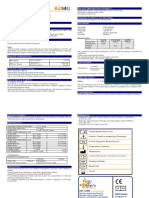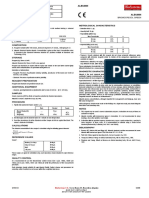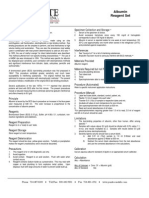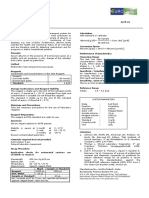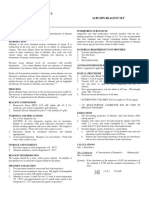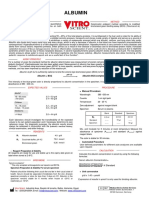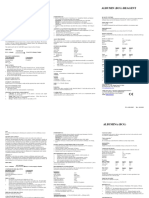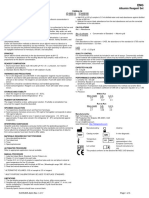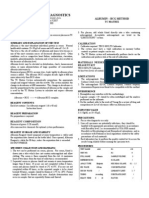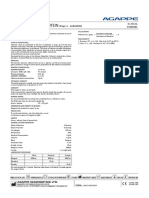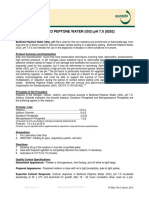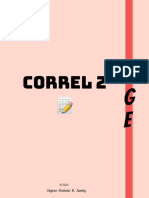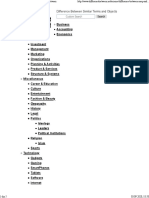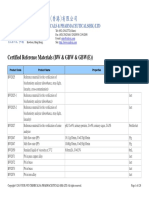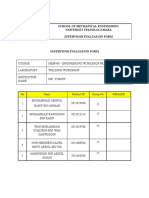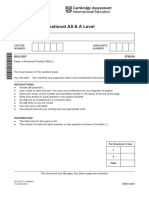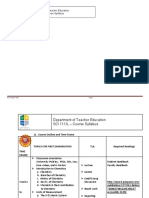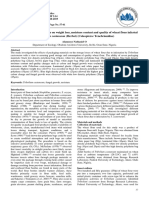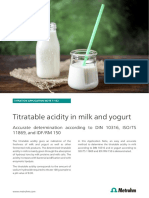ALBUMIN Ref.
: 19
Insert
Intended use . End point reaction system for albumin determination
in serum sample.
2. < - Standard 3.8 g/dL - Store at 2 - 8 ºC.
Reagent label bears expiration date. Bovine albumin (3.8 g/dL) and
sodium azide (0.1%).
Professional use.
[For in vitro diagnostic use.]
Precautions and warnings
Disposal of all waste material should be in accordance with local
Test principle . Albumin binds to several organic anions and complex guidelines.
molecules of stains. The measurement system is based on the peak
diversion of the maximum absorptivity of a complex stain (bromocresol The usual security cares should be applied on the reagent handling.
green) when it binds to albumin. The produced color is colorimetrically
measured between 600 and 640 nm, and is proportional to albumin The standard contain sodium azide as preservative. Avoid ingestion. In
concentration in sample up to 6.0 g/dL. case of eyes contact, immediately flush eyes with plenty of water and get
medical assistance.
Summary . The most common methods for albumin measurement are Sodium azide may react with lead and copper plumbing to form highly
based on the stain bindings. This binding produces a diversion of explosive metal azides. On disposal, flush with a large volume of water to
absorptivity peak of the stain, allowing that the resulted color may be prevent azide accumulation.
colorimetrically measured in the presence of stain excess. The high
affinity of albumin binding allows that all albumin molecules presented Storage and stability . Unopened reagents, when stored at
participates in the reaction. The system has a non-ionic detergent that indicated temperature, are stable up to expiration date shown on the label.
reduces the blank absorbance, avoiding clouding up and increases the In order to avoid evaporation of the Standard, keep the bottle tightly
linearity. closed.
Several stains such as methyl orange, HABA, bromocresol green (BCG) Deterioration . Microbial or chemical contamination may decrease
and bromocresol purple (BCP) have been used in serum albumin reagents stability.
measurement, but BCG is the most used reagent, and is recommended by Albumin is not suitable for use if Color Reagent has an absorbance over
AACC3. It has been also the choose method for laboratories because it 0.300 at 630 nm when measured versus water as reference.
was used by 60% of the laboratories from the College of American
Pathology proficiency program in 2002.
Specimen collection and preparation
Bromocresol green has specificity to albumin and do not suffer
interference of high bilirubin and hemoglobin values, allowing that the Use serum. Albumin is reportedly stable in serum for about 3 days at
interference of high triglycerides values may be corrected using the blank 2 - 8 ºC and 7 days at -10 ºC. Do not use plasma.
of the sample.
No known test method can offer complete assurance that human blood
The method has an excellent correlation with agarose gel electrophoretic samples will not transmit infectious diseases. Therefore, all blood
fractionation and it is easily applied to most automated and semi- derivatives should be considered potentially infectious.
automated systems which are able to measure, in an end point reaction
between 600 and 640 nm. Interference
Methodology . Bromocresol green Bilirubin up to 38 mg/dL, hemoglobin up to 180 mg/dL and triglycerides
up to 250 mg/dL do not interfere significantly.
Reagents Triglycerides values over 250 mg/dL produce positive interference that
may be minimized using the blank of the sample using 0.85% NaCl as
1. ( - Color Reagent - Store at 2 - 8 ºC.
Reagent label bears expiration date. Buffer pH 3.8 (60 mmol/L),
bromocresol green (300 mmol/L) and Brij 35 (³6.0 mmol/L).
diluent.
In depressed patients or obese people, albumin values tend to be lower.
Tourniquet use for more than 3 minutes provides increased albumin value.
Plasma obtained with lithium heparin and potassium oxalates combined
with sodium fluoride provide false decreased results.
01 English - Ref.: 19
�Materials required not provided Measurement/reportable range
1. Photometer capable of measuring absorbance at 600 - 640 nm. Up to 6 g/dL.
2. Pipettes to measure reagents and samples.
If Albumin concentration exceeds 6 g/dL, the sample must be diluted with
3. Timer. 0.85% NaCl. Multiply the result by the appropriate dilution factor.
Manual procedure Expected range6 . Each laboratory should evaluate the
transferability of the expected values to its own patient population and, if
Set up three tubes and proceed as follows: necessary, estimate its own reference interval.
Blank Unknown Standard
Color Reagent (nº 1) 1.0 mL 1.0 mL 1.0 mL Children and Teenagers8 (g/dL)
Sample 0.01 mL 1 - 30 days 2.6 - 4.3
Standard (nº 2) 0.01 mL 31 - 182 days 2.8 - 4.6
183 - 365 days 2.8 - 4.8
1 - 18 years 2.9 - 4.7
Mix and after 2 minutes, up to 10 minutes, measure the Unknown and
Standard absorbencies against the Blank at 630 nm or red filter (600 to
640). Adults . 3.5 up to 5.5 g/dL
Calibration Conversion . Conventional Unit (g/dL) x 144.9 = Unit IS (mmol/L).
The Standard is traceable to Certified Reference terial - CRM (BCR) 470 of
the Institute for Reference Materials and Measurements/ International Performance characteristics9
Federation of Clinical Chemistry (IRMM / IFCC).
Recovery studies . In two samples with albumin concentrations of
Manual calibrations 2.7 and 4.2 g/dL were added different quantities of the analyte.
Calculate the factor weekly. Subsequent analyses provided recoveries ranging from 97 to 103 %. The
mean proportional systematic error at 3.5 g/dL decision level was
Automatic Systems 0.04 g/dL or 1.1%.
Blank of reagents: water or 0.85% NaCl;
Standards: Calibra Series (Labtest calibrator for automated systems), Method comparison . A group of 80 sera were assayed by the
which are traceable to CRM (BCR) 470 of IRMM/IFCC. proposed method and a similar technique. Serum albumin values ranged
from 2.5 - 5.3 g/dL. The comparisons yielded a correlation coefficient of
Calibration frequency 0.994 and regression equation was y = 0.98x + 0.09. The mean
Two point calibration after reagent lot change; proportional systematic error at 3.5 g/dL decision level was 0.02 g/dL or
Two point calibration when the internal quality control indicates. 0.6 %.
Quality control . For quality control use Qualitrol H Level 1 and Imprecision - Within Run
Qualitrol H Level 2 or other suitable control material. The limits and control
Mean SD
interval must be adapted to the laboratory requirements. Each laboratory N (%) CV
(g/dL) (g/dL)
should establish corrective actions to be taken if values fall outside the
Sample 1 20 3.5 0.03 0.9
control limits.
Sample 2 20 5.2 0.06 1.2
Calculations
Imprecision - Run-to-Run
Aunknown Mean SD
Albumin (g/dL) = x 3.8 N (%) CV
(g/dL) (g/dL)
Astandard Sample 1 20 3.4 0.07 2.0
Sample 2 20 5.1 0.06 1.2
Due the high reproducibility obtained with this methodology, the factor
method may be used.
Analytical sensitivity . Detection limit: 0.015 g/dL. The detection
3.8 limit represents the lowest measurable albumin concentration that can be
Calibration factor = distinguished from zero. It is calculated as two standard deviations of 20
Astandard replicates of one sample without albumin. It was verified that the
photometric detection limit was 0.013 g/dL, what corresponds to an
absorbance equal to 0.001.
Albumin (g/dL) = AUnknown x Factor
02 English - Ref.: 19
�Notes Presentation
Product Reference Contents
1. The material cleaning and drying are fundamental factors to the 1 1 X 250 mL
reagent stability and to obtain correct results. Albumin 19-1/250
1 X 1 mL
Albumin 1 4 X 37 mL
2. The deionized or distilled water in the laboratory to prepare reagents, 19-4/37
Labmax 560/400 1 X 1 mL
use in the measurements and for final glass washing must have resistivity
³1 megaohm.cm, or conductivity £1 microsiemens/cm and silicates
concentration must be <0.1mg/L. Application procedures using Albumin are available for various
automated systems.
3. It is suggested to consult ‘‘www.fxol.org’’ in order to review
physiopathological source and drugs interference in results and The number of tests in automated systems depends of the programmed
methodology. parameters
References Customer information
1. Bartholomew RJ, Delaney AM. Proc Austral Assoc Clin Biochem 1966; [Warranty conditions]
1:214.
Labtest Diagnóstica warrants the performance of this product under the
2. Basques JCA, Cabral GL, Cruz RS. Com II Congr Bras Anal Clin. specifications until the expiration date shown in the label since the
Janeiro, 1972. application procedures and storage conditions, indicated on the label and
in this insert, have been followed correctly.
3. Tonks DB. Quality Control in Clinical Laboratories. Wamer Chilcott
Laboratories, Diagnosis Reagents Division. Scarborough, Canada,
1972. Labtest Diagnóstica S.A.
CNPJ: 16.516.296 / 0001 - 38
4. Peters T, Biamont GT, Doumas BT. Albumin in serum. Em Faulkner WR. Av. Paulo Ferreira da Costa, 600 - Vista Alegre - CEP 33240-152
Meites S, eds. Selected methods of Clinical chemistry, v. 9, Lagoa Santa . Minas Gerais Brasil - www.labtest.com.br
Washington: AACC Press, 1982:319.
Customer Service e-mail: customerservice@labtest.com.br
5. Westgard JO, Groth T. Clin Chem. 27:493-501,1981.
Edição: July, 1994 Copyright by Labtest Diagnóstica S.A.
6. Sociedad Española de Bioquímica Clínica y Patología Revision: March, 2013 Reproduction under previous autorization
M o l e c u l a r, B a s e d e D a t o s d e Va r i a c i ó n B i o l ó g i c a . Ref.: 020522(02)
Disponívelem:<http://www.seqc.es/ar ticle/ar ticleview/330/1/170>
(accessed on 2006/04).
7. Basques JC. Especificações da Qualidade Analítica. Labtest
Diagnóstica 2005.
8. Soldin SJ, Brugnara C, Wong EC: Pediatric Reference Ranges, 5a.
edição, Washington: AACC Press, 2005:5-6.
9. Labtest: data on file.
03 English - Ref.: 19
� Símbolos utilizados com produtos diagnósticos in vitro
Símbolos usados con productos diagnósticos in vitro
Symbols used with ivd devices
Conteúdo suficiente para < n > testes Risco biológico
Contenido suficiente para < n > tests Riesgo biológico
Contains sufficient for < n > tests Biological risk
Data limite de utilização (aaaa-mm-dd ou mm/aaaa) Marca CE
Estable hasta (aaaa-mm-dd o mm/aaaa) Marcado CE
Use by (yyyy-mm-dd or mm/yyyy) CE Mark
Material Calibrador Tóxico
Material Calibrador Tóxico
Calibrator Material Poison
Material Calibrador Reagente
Material Calibrador Reactivo
Calibrator Material Reagent
Limite de temperatura (conservar a) Fabricado por
Temperatura limite (conservar a) Elaborado por
Temperature limitation (store at) Manufactured by
Representante Autorizado na Comunidade Europeia Número do lote
Representante autorizado en la Comunidad Europea Denominación de lote
Authorized Representative in the European Community Batch code
Consultar instruções de uso Controle
Consultar instrucciones de uso Control
Consult instructions for use Control
Número do catálogo Controle negativo
Número de catálogo Control negativo
Catalog Number Negative control
Adições ou alterações significativas Controle positivo
Cambios o suplementos significativos Control positivo
Significant additions or changes Positive control
Produto diagnóstico in vitro Controle
Dispositivo de diagnóstico in vitro Control
In vitro diagnostic device Control
Liofilizado Corrosivo
Liofilizado Corrosivo
Lyophilized Corrosive
Período após abertura Uso veterinário
Período post-abertura Uso veterinario
Period after-opening Veterinary use
Instalar até Fabricado em
Instalar hasta Elaborado en
Install before Manufactured on
Produto de uso único
2 Producto de un solo uso
Single use product
Ref.: 280322
04 English - Ref.: 19







